How to clean the kettle from scale and other contaminants?
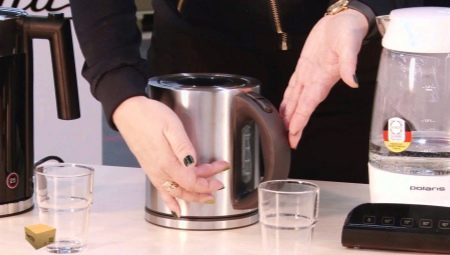
Many people turn a blind eye to the problem of scale, but from time to time it eats into the surface of the kettle more and more, and then no folk remedies will help you cope with this trouble. In this case, you just spoil your kitchen "friend" and spend money on purchasing a new one. To avoid this, it is worth understanding the causes of scale, its consequences and methods of cleaning.

Reasons for the appearance
The main cause of scale formation in your kettle is water. But if for a person it does not pose a great danger, then for a kitchen appliance it is a lethal liquid. Normal running water contains many impurities such as magnesium, calcium and various salts. When a person boils water, metal particles accumulate inside the kettle, in particular, this plaque remains on the heating element.
It is important to do preventive cleaning on time, otherwise the plaque will become thick and completely destroy your kettle in a short period of time.

Funds
Seeing the plaque on the dishes, everyone understands that they need to get rid of it. Unfortunately, it is not always possible to achieve the desired result immediately. In most cases, we immediately run to the hardware store, buy a descaler, forgetting that it can harm our health more than the scale itself. There are many other ways to clean kitchen appliances that are safer and won't hurt your wallet.
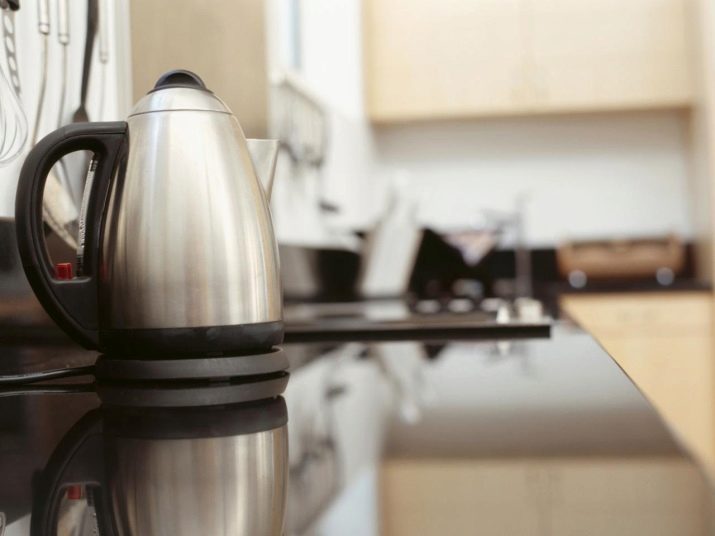
Folk
You can destroy plaque from a metal kettle acetic acid. This method is recognized as the most effective. You will need 100 ml of vinegar per liter of water. The solution obtained as a result of mixing must be poured into a kettle and boiled properly. Wait 15-20 minutes. During this time, the scale should completely disappear. The walls of the kettle may not be completely cleaned. In this case, the procedure can be repeated. Do not use undiluted vinegar as the liquid can destroy the electroplated coating of the heating coil.

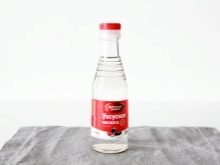
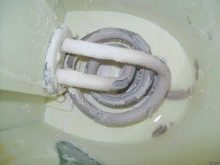
The usual baking soda, which is in every home. One has only to pour water into the container and add a spoonful of this product. You need to heat everything on low heat until the scale layer falls behind.
The main thing is to remember that this method is only suitable for a metal or enamel teapot.
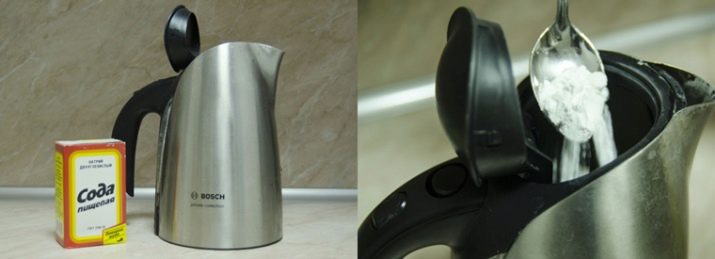
A good remedy for combating plaque is considered lemon acid... It can be used with any heating element.
Citric acid can clean your appliance better and safer than soda and vinegar.
When preparing a cleaning agent, pour one liter of water into a container and add two tablespoons of citric acid. The water must be boiled and cooled, then drained, rubbed with a sponge the remaining lime and thoroughly rinsed the kettle.
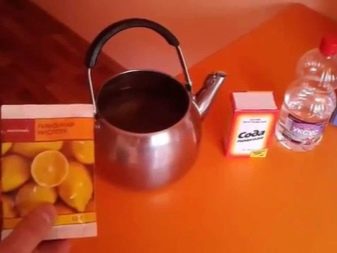
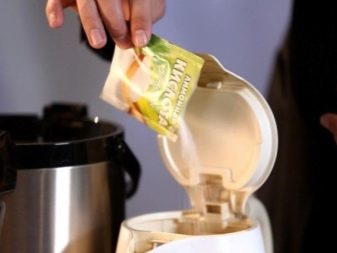
It turns out that everyone's favorite drink Coca-cola able to deal with plaque in your teapot. To test the effectiveness of such a tool, you first need to buy a drink and let it run out of steam. After that, calmly pour the cola into the kettle until about the middle and heat over low heat until the lime is gone.
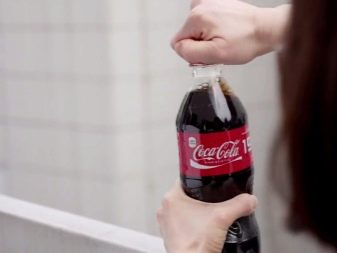
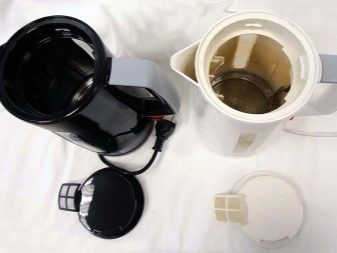
Remember that this method, while effective, is not suitable for all teapots.
Electric kettles should not be cleaned in this way, the liquid can leave a yellow coating on the white surface. After that, it is difficult to wash the resulting yellowness from the plastic device.
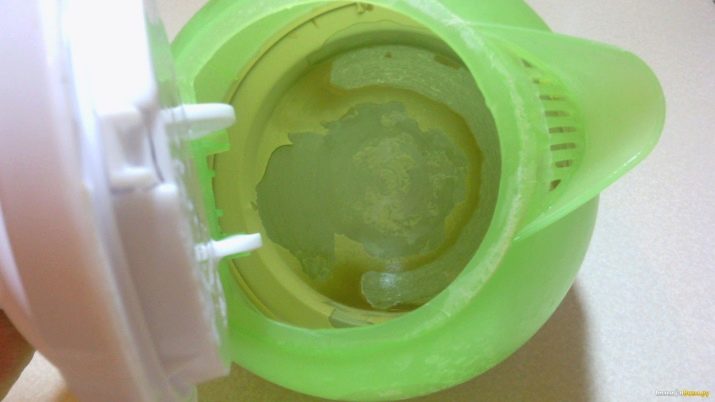
Universal
If the recipes described above did not help, you will have to apply more drastic ways to solve the problem. Many chemicals are ready to help you with this.
For washing machines and dishwashers, a detergent is often used Eona bio”, But it can be easily used to combat scale. The liquid is diluted with hot water and poured into the kettle. By the same principle, you can useь Calgon, "Mister Des Antikipin", "Chistin"... Scale is also used Refine, Astonish Limescale Remover, Selena. All these solutions are used to remove scale in teapots, irons, coffee makers.
It is worth noting that, more often than not, difficult pollution is dealt with faster and more efficiently by means at a minimal cost than expensive ones.
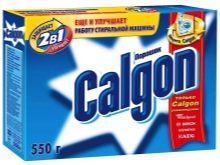
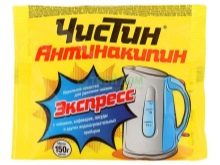

Chemical
Descaling can be difficult at times. Therefore, sometimes it is necessary to use heavy chemical "artillery". In any hardware store, they will recommend various preparations to combat the hated scale. Many housewives advise using the product "Anti-scale".
However, it is worth buying several such packs at once, since one will not be enough.

There are many more different means to combat scale. Some of the more popular ones are:
- Frau Schmidt;
- Clean home;
- Romax anti-scale;
- Melitta Anti Calc;
- Tytan;
- Domol;
- "Bugi Anvit";
- Pure water.
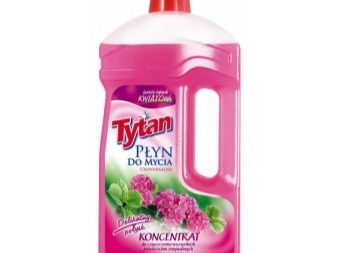
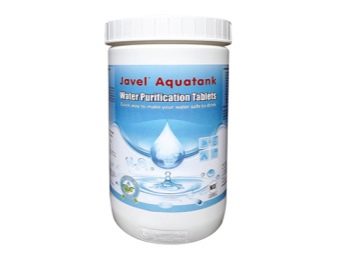
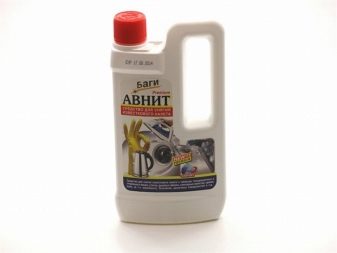
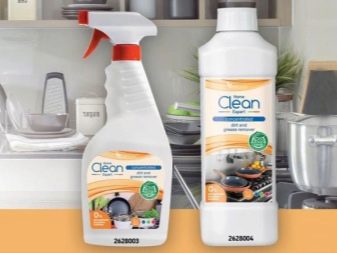
According to the principle of action, all chemicals are the same. The substance is applied to the surface and triturated thoroughly. The kettle will soak for five minutes, after which the solution is washed off. A liquid or tablet chemical is dissolved in hot water and poured into a kettle. It remains only to boil and then rinse it.
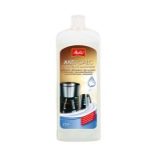
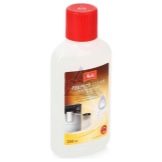

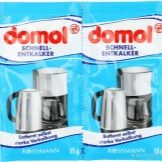
How to wash?
Cleaning the kettle at home is easy. However, it is important to select the appropriate method for your specific instrument.
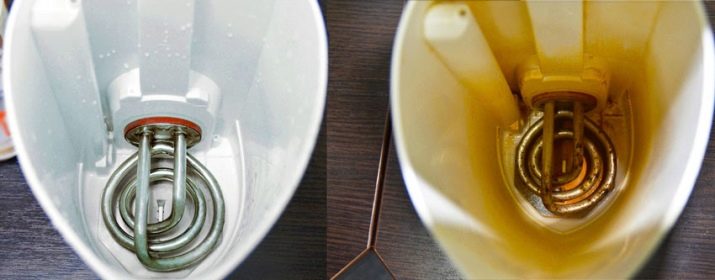
Electric
The electric kettle is not recommended to be washed with vinegar and Coca-Cola. If your kitchen friend has a plastic or glass body, the consequences can be very unpredictable. Better to clean it with citric acid. When preparing the solution, one spoonful of acid and a liter of water will be enough. After boiling, let the appliance cool down, drain the liquid and rinse thoroughly.
Before use, be sure to boil the water several times and drain.
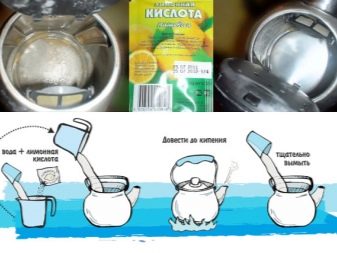
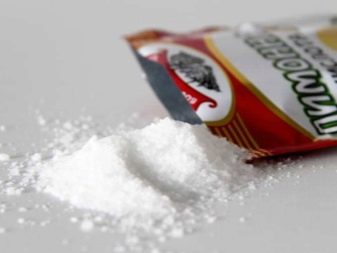
Metal
To rid this model of a teapot from unpleasant plaque will turn out to be vinegar. It used to be used against scale on copper teapots. This method is suitable for all iron and metal models, except for aluminum ones. Dilute 150 ml of vinegar with water, heat the solution over a fire. Complete cleaning usually takes 20 minutes. As soon as the kettle has cooled down, pour out the water and rinse with warm water.
Another "tablet" for getting rid of small scale deposits for enamel teapots is peel from apples or pears... Just pour water into the kettle, drop the peel into it and boil it. Clean the inside of the container with a sponge and rinse with water.
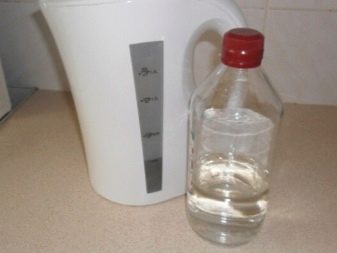
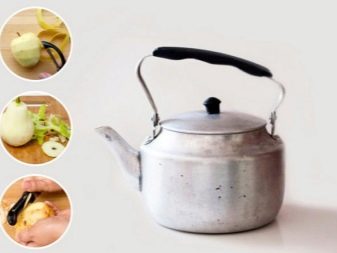
Glass
You can clean your glass teapot with vinegar essence. There is nothing difficult here. You need to mix one glass of water and a glass of vinegar, fill the container with all this and heat it over low heat. Then leave for several hours, rinse and dry.
In case you don't feel like messing around with vinegar, use baking soda. Dissolve a spoonful of baking soda in hot water, boil for ten minutes. Then rinse and wipe the kettle.
If neither of the two options helps with limescale, mix the water with vinegar and baking soda. Bring the resulting solution to a boil and let stand for 30 minutes. Then cool the device and rinse the container.
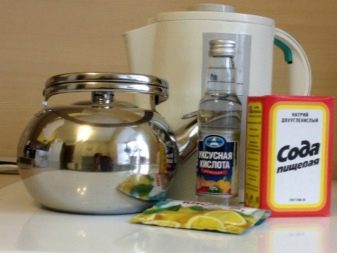
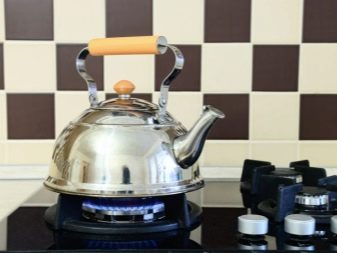
Another way to give your kettle a fresh look is lemon acid... Here you can apply the acid itself, juice or lemon wedges. For a liter of water, prepare one tablespoon of acid (1 spoonful of lemon juice or 1 wedge). Boil the resulting mixture, let cool and rinse the device.
Lemon juice can also be mixed with vinegar. This option will also help get rid of scale. Mix a quart of water with equal amounts of vinegar and lemon juice. Boil, then rinse.
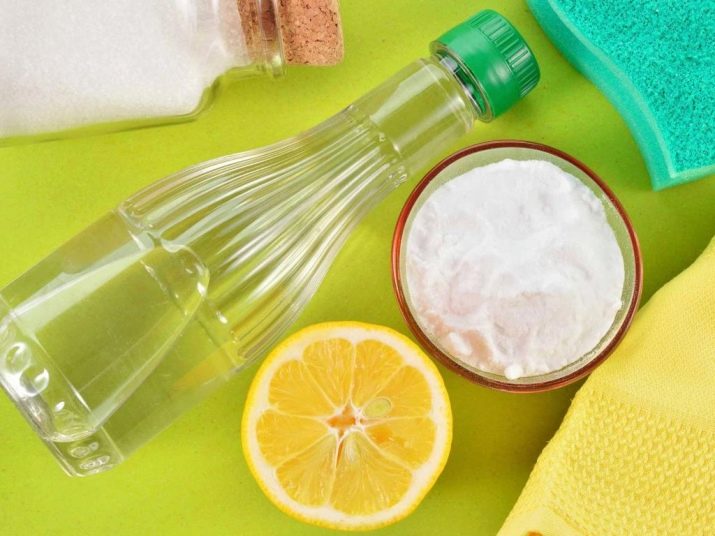
Ceramic
Ceramic teapots are distinguished by their beauty and durability. They require careful handling. Since the ceramic coating is fragile, any cleaning can damage the surface of the device.
To clean it, you should use gentle agents, one of which is vegetable pickle.
It is boiled in a container, after which it is necessary to allow the device to cool down. Next, you need to wash off the scale with a sponge and detergent. There are no special recommendations for cleaning ceramic teapots, you can use any other method described above, but it is worth significantly reducing the concentration of an aggressive substance.

Especially neglected cases
The use of several active ingredients will help to cope quickly with a complex mission of descaling. To prepare it you will need water, soda, citric acid and 100 ml vinegar... Next, pour water into a container, add one spoonful of soda and bring to a boil. Then we drain the solution, fill the kettle with water, add acid, boil and let it warm up for about 20 minutes, drain the liquid. At the end, pour vinegar essence into a container, boil for 30 minutes, pour out and rinse everything thoroughly with running water.
A trio of vinegar, baking soda, and a sponge will do the trick too. Pour soda on a sponge soaked in vinegar solution and grind until porridge is formed. With the mixture, you need to clean the dirty areas and rinse well.
Strong limescale can be removed by using citric acid in tandem with regular washing powder.
Fill a container with water, add some powder and boil. Add citric acid to the same solution (one spoon will be enough) and set to boil again. The device will need to cool down, then rinse the contents and rinse thoroughly.
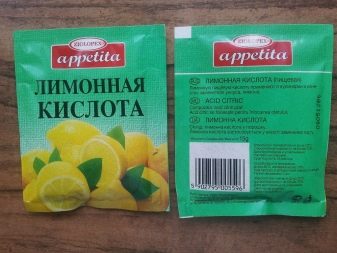
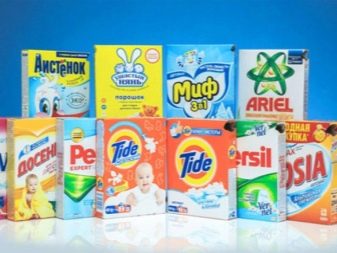
How to clean rust?
Rust often forms on the surface of the teapot. You can remove these contaminants citric acid... It will not damage metal walls. Stubborn rust stains on the outside of the kettle should be removed in a few steps. Submerge the kettle in citric acid for a couple of hours. To prepare the solution, you need to mix 2-3 tablespoons of powder and a glass of water. Then use a toothbrush to clean the surface. If the procedure does not help, repeat all over again.
Small dirt will be removed with a solution consisting of 1 glass of water and 1 tablespoon of powder. Apply the liquid with a sponge to the stained area and wipe well.
Do not forget that every time after the procedure, the device must be rinsed and wiped dry.
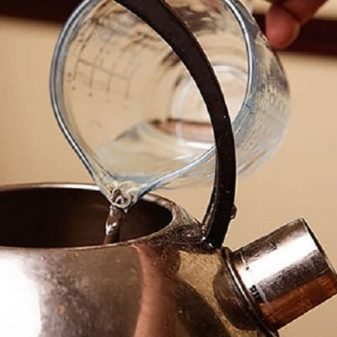
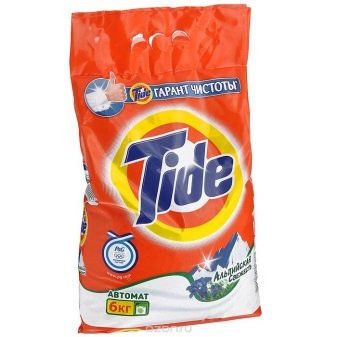
If rust forms inside the kettle, clean it with a citric acid solution. with a concentration of 10%... Let the crockery stand for 10 hours or overnight. In the morning, drain the contents from the container and rinse off all rust and mortar residues. If you are not satisfied with the result, the procedure can be repeated.
Before using the kettle, it is necessary to boil the water 2-3 times and drain it.
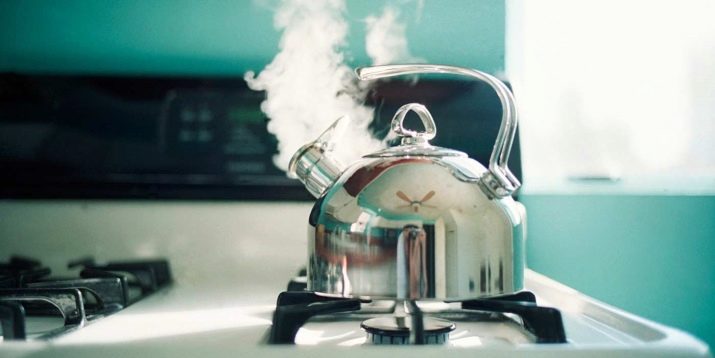
How to remove tea plaque?
Periodically, tea bloom appears on the surface of mugs or teapots. Most often this happens due to the fact that the dishes are not washed for a long time.... Coloring substances of drinks form a plaque that accumulates, and not only can spoil the taste of the drink, but also outwardly gives the mugs a completely unpresentable look. One gets the impression that you have to drink from dirty dishes.
The best and surest way to combat this plaque is to try to wash the dishes after each use. If there is not always enough time for this and the presence of such dishes in the house is a fact, then the cleaning agents intended for this will come to the rescue. The most common use of this is baking soda. It removes such plaque well.
However, you need to consider the fact that regular use of baking soda can harm your dishes.
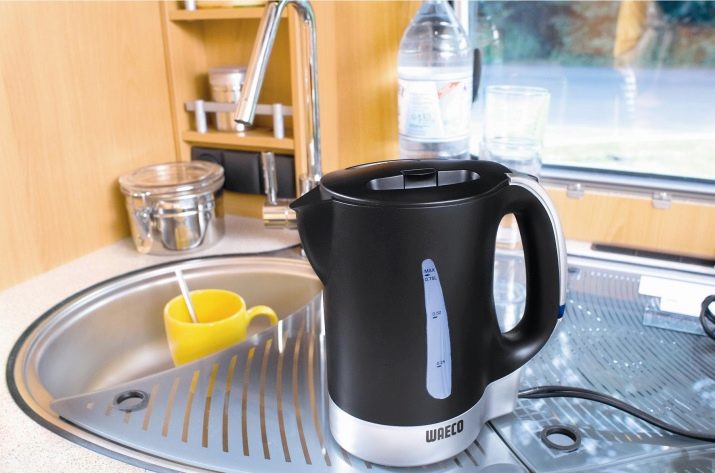
You can also remove plaque at home using other methods. For example, many advise using kefir or green tea for cleaning. At first glance, this is absurd, but according to the housewives, if you fill a cup with kefir or green tea and leave it overnight, then in the morning you only need to rinse it and enjoy their cleanliness.
Someone cleans dishes with salt, but forgets that it can damage the surface. Scratches may appear on the walls. Therefore, it is best to use a saline solution. Dissolve salt in hot water, and then wash the dishes in this liquid.
It is worth remembering that not only tea and other drinks can leave plaque. The main pest, oddly enough, is tap water. Therefore, it is recommended to dry the dishes after washing.
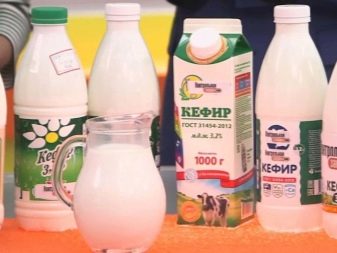
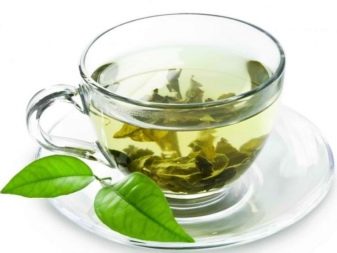
How to wipe off fat and carbon?
From time to time, all kitchen utensils become a victim of greasy deposits and carbon deposits. You can deal with an unpleasant layer with citric acid. To eliminate small oily stains, take a lemon wedge, dip it in fine salt and wipe the dirty area.
You don't need to use salt to clean metal surfaces. They may darken.
Outside, you can wash the burnt layer and greasy deposits from the teapot by immersing it in a container with lemon solution for several hours. To do this, you need to mix lemon powder and water in a ratio of 1: 5. The temperature of the resulting mixture should be high, then the solution will clear the dishes from burning faster.
If the stains are already old, then it will help to remove them. baking soda and citric acid. The ingredients are mixed in equal proportions to form a mixture that must be coated on the damp surface of the teapot. The solution will chemically react with the fat and aid in the removal of the fat. After application, you need to give a little time for the reaction, and then remove the layer of dirt with a sponge and wash the dishes.
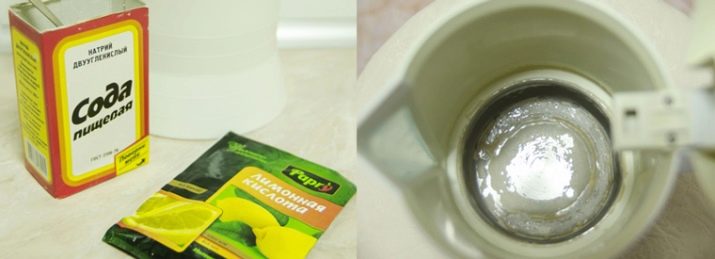
Prevention measures
In order for the problem of combating scale to appear less often, it is necessary follow some guidelines:
- Use only filtered water for boiling in a kettle.
- Slightly formed plaque is easier to remove. Therefore, the device should be cleaned as soon as possible once a month. Ideally, once a week.
- Do not keep water in the container. It is better to leave the kettle dry, then it will last longer.
- It is recommended to rinse the kettle daily.
- Boil the water periodically with the addition of citric acid. You can simply leave the kettle on for a few hours with the acidified solution.
- If you find that the heating coil or disc has changed color, it is worth considering purchasing a new kettle.
For information on how to effectively descale the kettle, see the next video.








